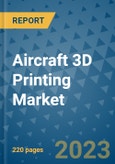Market Drivers
Growing Demand for Lightweight Aircraft Components
Heavy auxiliary components in aircraft, satellites, and rockets increase operational costs. 3D printing offers a solution by manufacturing lighter parts, reducing fuel consumption, carbon emissions, and operational expenses. The technology also finds relevance in satellite missions that prioritize lighter payloads for space travel.Reduced Production Time through Technological Advances
Emerging 3D printing technologies have drastically reduced production times from months to days compared to traditional manufacturing processes. This acceleration is supported by innovative techniques like continuous liquid interface production (CLIP) that expedite manufacturing processes.Market Challenges
Long Manufacturing Cycles for High-Volume Production
3D printing's high operational and procurement costs compared to traditional manufacturing can impede market growth. Additionally, as production scales, costs rise, making 3D printing less suitable for high-volume production. The technology's relatively slower high-volume production also hampers its adoption.Segment Analysis
Printer Segment Driven by Custom Manufacturing Demand
The global aircraft 3D printing market is segmented into printers, materials, services, and software offerings. The printers segment is anticipated to dominate the market due to increased demand for cost-efficient and custom manufacturing.FDM Technology Takes Center Stage
In the technology segment, polymerization, powder bed fusion, and material extrusion or fusion deposition modeling (FDM) are the major categories. The FDM segment is expected to lead due to its efficiency in manufacturing large volumes with minimal waste and varying shapes, textures, thicknesses, and colors.Aircraft Segment's Prominence
The aircraft, UAVs, and spacecraft form the platform segment. The aircraft segment is projected to maintain its dominance due to the growing demand for lightweight and cost-efficient aircraft. 3D printing enables rapid manufacturing of complex aircraft parts, aligning with sustainability goals.Regional Overview
North America's Leading Role
North America is poised to lead the global aircraft 3D printing market due to its adoption of 3D printing for manufacturing complex components. Switching to 3D printing for less complex parts and lightweight components has further bolstered the region's position.Asia Pacific's Rapid Growth
Asia Pacific is expected to experience the highest growth rate. The region's adoption of 3D printing for small component manufacturing in space and aircraft systems is a key driver for market growth.Key Industry Players
Prominent players include SLM Solutions Group AG (Germany), 3D Systems (US), Stratasys (Israel), General Electric Company (US), Materialise (Belgium), and others. These companies are at the forefront of innovation, leveraging collaborations and technological advancements.The global aircraft 3D printing market is on a trajectory of growth, driven by innovative designs, lightweight component demands, and reduced production times. Challenges related to cost and scalability need to be addressed to unlock the full potential of 3D printing in aerospace manufacturing. As North America maintains its dominance, Asia Pacific emerges as a promising market. The industry's key players are spearheading advancements and collaborations, shaping the future of aircraft manufacturing.
This product will be delivered within 1-3 business days.
Table of Contents
1. Executive Summary
2. Market Overview
3. Price Trends Analysis and Future Projects, 2018 - 2030
4. Global Aircraft 3D Printing Market Outlook, 2018 - 2030
5. North America Aircraft 3D Printing Market Outlook, 2018 - 2030
6. Europe Aircraft 3D Printing Market Outlook, 2018 - 2030
7. Asia Pacific Aircraft 3D Printing Market Outlook, 2018 - 2030
8. Latin America Aircraft 3D Printing Market Outlook, 2018 - 2030
9. Middle East & Africa Aircraft 3D Printing Market Outlook, 2018 - 2030
10. Competitive Landscape
11. Appendix
Companies Mentioned
- 3D Systems
- Stratasys Inc.
- Heraeus
- EPLUS 3D
- EOS GmbH
- Norsk Titanium
- Velo3D
- GE Additive
- Aurum 3D
- ENVISIONTEC US LLC
- Ultimaker
- Materialise NV
Methodology

LOADING...








